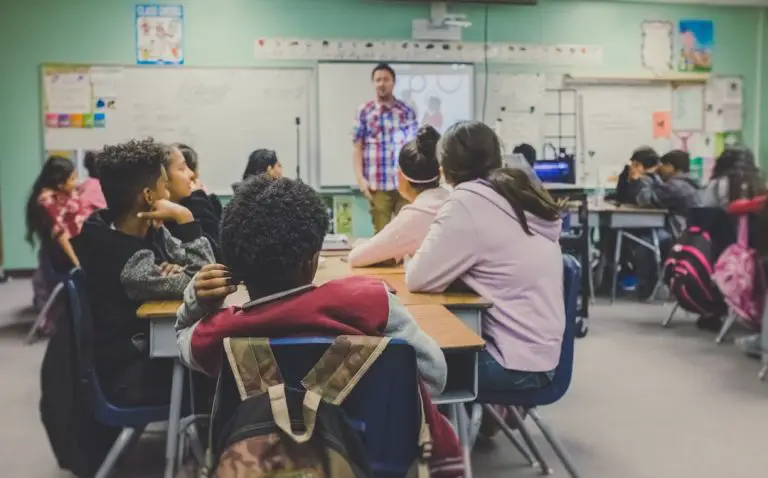Support our educational content for free when you buy through links on our site. Learn more
30 Game-Changing Examples of Effective Teaching Strategies in the Classroom for 2025! 🎓
Are you ready to transform your classroom into a vibrant learning hub? In a world where student engagement is more crucial than ever, effective teaching strategies can make all the difference. Imagine walking into a classroom where students are not just passive listeners but active participants, eagerly collaborating and problem-solving together. Sounds like a dream, right? Well, it doesn’t have to be!
In this article, we’ll explore 30 innovative teaching strategies that will not only captivate your students but also enhance their learning experience. From active learning techniques to technology integration, these strategies are designed to cater to diverse learning styles and foster a love of learning. So, whether you’re a seasoned educator or just starting your teaching journey, you’ll find valuable insights and practical tips to elevate your teaching game!
Key Takeaways
- Diverse Strategies Matter: Implementing a variety of teaching strategies, such as active learning and differentiated instruction, can significantly enhance student engagement and understanding.
- Technology is Your Ally: Integrating technology in the classroom, like using interactive apps and educational games, can create a more dynamic learning environment.
- Student-Centered Approaches: Emphasizing student-centered learning techniques, such as choice boards and collaborative projects, empowers students to take ownership of their learning.
- Continuous Feedback is Key: Utilizing formative assessments helps you gauge student understanding and adjust your instruction accordingly, ensuring all students succeed.
Ready to dive deeper into these strategies? Check out our recommendations for classroom supplies and educational games to get started on your journey to becoming an even more effective educator!
Table of Contents
- Quick Tips and Facts
- The Evolution of Effective Teaching Strategies
- Top 30 Effective Classroom Teaching Strategies You Need to Know
- Innovative Techniques for Engaging Students
- Student-Centered Learning Approaches
- Math Teaching Strategies That Work Wonders
- Resources for Effectively Implementing Teaching Strategies
- Final Thoughts on Effective Teaching Practices
- Create Your Free Teacher Account
- Prodigy’s Privacy Preference Center
- Conclusion
- Recommended Links
- FAQ
- Reference Links
Quick Tips and Facts 💡
- Effective teaching is a dynamic process: It’s like cooking – you wouldn’t use the same recipe for every dish! You need a variety of instructional strategies to cater to diverse learners.
- Engagement is key: Think of yourself as a magician, captivating your audience (your students!) with exciting activities and thought-provoking questions.
- Assessment isn’t just about grades: It’s a flashlight, illuminating your students’ understanding and guiding your instruction.
- Don’t be afraid to experiment! Just like a scientist, try new teaching strategies and see what works best for you and your students.
The Evolution of Effective Teaching Strategies ⏳
Remember the days of rote memorization and endless lectures? Thankfully, teaching has come a long way! From traditional methods to modern, research-backed approaches, the evolution of effective teaching strategies reflects a growing understanding of how students learn best.
From Sage on the Stage to Guide on the Side
The traditional model of teaching, with the teacher as the primary source of knowledge, has shifted towards a more student-centered approach. This recognizes that students are active learners who construct their own understanding.
The Rise of Technology in the Classroom
From interactive whiteboards to educational apps, technology has revolutionized the way we teach and learn. It can enhance engagement, provide personalized learning experiences, and extend learning beyond the classroom walls.
A Focus on 21st-Century Skills
In today’s rapidly changing world, it’s more important than ever to equip students with 21st-century skills like critical thinking, collaboration, communication, and creativity. Effective teaching strategies foster these skills through project-based learning, problem-solving activities, and real-world applications.
Top 30 Effective Classroom Teaching Strategies You Need to Know 🚀
Ready to supercharge your teaching? Here are 30 effective classroom teaching strategies that can help you create a dynamic and engaging learning environment:
- Active Learning: Get those brains buzzing! Incorporate activities like think-pair-share, role-playing, simulations, and hands-on experiments to make learning interactive and fun.
- Assessment for Learning: Ditch the “gotcha” quizzes! Use formative assessments like exit tickets, quick writes, and thumbs up/down checks to monitor student understanding and adjust your teaching on the fly.
- Collaborative Learning: Two heads are better than one! Encourage teamwork through group projects, peer teaching, and collaborative problem-solving activities.
- Differentiated Instruction: One size doesn’t fit all! Cater to diverse learning styles and needs by providing choices in assignments, varying levels of support, and using multiple modalities (visual, auditory, kinesthetic).
- Technology Integration: Embrace the digital age! Use technology to create interactive lessons, provide personalized learning experiences, and connect with students beyond the classroom.
- Inquiry-Based Learning: Spark curiosity! Pose thought-provoking questions that guide students to discover answers through exploration and investigation.
- Project-Based Learning: Make learning relevant! Engage students in real-world projects that require them to apply their knowledge and skills to solve authentic problems.
- Game-Based Learning: Learning can be fun! Incorporate educational games and simulations to motivate students, reinforce concepts, and develop critical thinking skills.
- Flipped Classroom: Flip the script! Have students watch lectures at home and use class time for interactive activities, discussions, and practice.
- Blended Learning: Combine the best of both worlds! Integrate online learning activities with traditional classroom instruction to create a flexible and personalized learning experience.
- Student-Centered Learning: Empower your students! Create a learning environment where students take ownership of their learning by setting goals, choosing activities, and reflecting on their progress.
- Mastery Learning: Aim for mastery! Provide students with multiple opportunities to demonstrate their understanding of key concepts before moving on.
- Personalized Learning: Tailor the learning experience! Use technology and data to create individualized learning paths that address each student’s unique needs and goals.
- Universal Design for Learning (UDL): Make learning accessible to all! Design lessons and assessments that are flexible and adaptable to meet the needs of diverse learners.
- Culturally Responsive Teaching: Celebrate diversity! Create a welcoming and inclusive classroom environment that values and respects the cultural backgrounds of all students.
- Trauma-Informed Teaching: Be sensitive to students’ experiences. Create a safe and supportive learning environment that acknowledges the impact of trauma on learning.
- Social-Emotional Learning (SEL): Nurture the whole child! Integrate activities that promote self-awareness, self-regulation, social awareness, relationship skills, and responsible decision-making.
- Growth Mindset: Cultivate a love of learning! Encourage students to embrace challenges, learn from mistakes, and believe in their ability to grow and improve.
- Mindfulness in the Classroom: Find your zen! Incorporate mindfulness practices like breathing exercises and guided meditations to help students focus, manage stress, and improve self-regulation.
- Formative Assessment: Check for understanding along the way! Use a variety of formative assessment strategies to monitor student progress, identify areas of need, and adjust instruction accordingly.
- Summative Assessment: Measure learning at the end! Use summative assessments like tests, projects, and presentations to evaluate student learning at the end of a unit or course.
- Authentic Assessment: Bring learning to life! Use authentic assessments that require students to apply their knowledge and skills to real-world situations.
- Performance-Based Assessment: Show what you know! Use performance-based assessments like presentations, debates, and role-playing to allow students to demonstrate their understanding in a creative and engaging way.
- Peer Assessment: Learn from each other! Incorporate peer assessment activities to provide students with feedback from their peers and develop their self-assessment skills.
- Self-Assessment: Take ownership of your learning! Encourage students to reflect on their own learning, set goals, and monitor their progress.
- Effective Questioning Techniques: Ask the right questions! Use a variety of questioning techniques to stimulate critical thinking, promote discussion, and assess student understanding.
- Classroom Management Strategies: Create a positive learning environment! Establish clear expectations, routines, and procedures to manage student behavior and create a positive and productive learning environment.
- Parent Engagement: Partner with parents! Communicate regularly with parents about their child’s progress, involve them in school events, and provide them with resources to support their child’s learning at home.
- Professional Development: Never stop learning! Engage in ongoing professional development to stay up-to-date on the latest research, best practices, and innovative teaching strategies.
- Teacher Collaboration: Work together! Collaborate with colleagues to share ideas, plan lessons, observe each other’s classrooms, and provide support.
Innovative Techniques for Engaging Students 🤩
Let’s face it, even the most exciting subject matter can feel dry without the right approach. Here are some innovative techniques to transform your classroom into a hub of engagement:
-
Escape Rooms: Turn your classroom into a real-life puzzle! Escape rooms require students to work together, solve clues, and think critically to “escape” within a set time limit. This immersive experience can make learning any subject matter unforgettable.
-
Interactive Technology: Ditch the static presentations! Tools like Pear Deck, Nearpod, and Quizizz allow you to create interactive lessons, quizzes, and games that keep students actively participating and engaged.
👉 Shop Interactive Whiteboards on: Amazon
- Pear Deck: Official Website
- Nearpod: Official Website
- Quizizz: Official Website
-
Student-Created Content: Empower your students to become the teachers! Have them create videos, podcasts, infographics, or even board games to teach concepts to their peers. This not only deepens their understanding but also fosters creativity and communication skills.
👉 Shop Podcast Microphones on: Amazon
-
Outdoor Learning: Take advantage of the great outdoors! Bring your lessons to life by conducting nature walks, science experiments, or even just reading aloud under a shady tree. Fresh air and a change of scenery can work wonders for engagement.
Student-Centered Learning Approaches 🤔
Imagine a classroom where students are not passive recipients of information but active participants in their own learning journey. That’s the essence of student-centered learning! Here are some powerful approaches to make it a reality:
-
Choice Boards: Empower students with choice! Create a choice board with a variety of activities related to a specific learning objective. Students can choose the activities that best suit their learning styles and interests, fostering ownership and motivation.
-
Jigsaw Activities: Turn collaboration into a puzzle-solving adventure! In a jigsaw activity, students become “experts” on a specific aspect of a topic and then teach their knowledge to others. This promotes teamwork, communication, and a deeper understanding of the material.
-
Learning Stations: Transform your classroom into a dynamic learning hub! Set up different learning stations with various activities related to a topic. Students can rotate through the stations at their own pace, engaging with the material in diverse ways.
👉 CHECK PRICE on: Amazon
-
Student-Led Conferences: Shift the power dynamic! In student-led conferences, students take the lead in discussing their progress, goals, and areas for improvement with their parents and teachers. This fosters self-reflection, responsibility, and communication skills.
Math Teaching Strategies That Work Wonders ➗➕➖✖
Math can be a source of anxiety for some students, but it doesn’t have to be! Here are some engaging and effective strategies to make math come alive:
-
Manipulatives: Bring abstract concepts to life! Use manipulatives like blocks, counters, and fraction circles to help students visualize and understand mathematical concepts.
👉 CHECK PRICE on: Amazon
-
Real-World Applications: Show the relevance of math! Connect math concepts to real-world situations through word problems, projects, and discussions. For example, students can use math to calculate the cost of a grocery list, design a garden, or track their progress in a sport.
-
Games and Puzzles: Make math fun! Incorporate math games, puzzles, and riddles into your lessons to engage students, reinforce concepts, and develop problem-solving skills.
👉 CHECK PRICE on: Amazon
-
Technology Integration: Leverage the power of technology! Use math apps, websites, and software to provide students with interactive practice, personalized instruction, and visual representations of mathematical concepts.
👉 Shop Math Software on: Amazon
-
Growth Mindset in Math: Encourage a “can-do” attitude! Help students develop a growth mindset by praising their effort, persistence, and use of strategies, rather than just focusing on correct answers.
Resources for Effectively Implementing Teaching Strategies 🧰
Feeling overwhelmed by the sheer number of teaching strategies? Don’t worry, you don’t have to go it alone! Here are some valuable resources to support you in effectively implementing these strategies:
-
Teacher Strategies™: That’s us! We offer a wealth of resources, including articles, tips, and professional development opportunities, to help you create an engaging and effective learning environment. Check out our categories on Instructional Strategies, Lesson Planning, Instructional Coaching, Classroom Management, and Differentiated Instruction to get started. For specific examples of effective teaching strategies, be sure to read our article on What are examples of effective teaching strategies?
-
Teaching Tolerance: Promote diversity and inclusion in your classroom with resources from Teaching Tolerance. They offer lesson plans, articles, and professional development opportunities to help you create a welcoming and equitable learning environment for all students.
Teaching Tolerance: Official Website
-
ASCD: Stay up-to-date on the latest research and best practices in education with resources from ASCD. They offer books, articles, professional development, and a supportive community of educators.
ASCD: Official Website
-
Edutopia: Find inspiration and practical ideas from Edutopia, a website dedicated to transforming K-12 education. They offer articles, videos, and resources on a wide range of topics, including teaching strategies, classroom management, and technology integration.
Edutopia: Official Website
-
Pinterest: Yes, even Pinterest can be a valuable resource for teachers! Search for specific teaching strategies, classroom decor ideas, or organizational tips, and you’ll find a plethora of creative and practical ideas from fellow educators.
Pinterest: Official Website
Final Thoughts on Effective Teaching Practices 🤔
Effective teaching is an ongoing journey, not a destination. It requires a willingness to reflect, adapt, and continuously learn and grow alongside your students. By embracing a student-centered approach, incorporating engaging strategies, and utilizing available resources, you can create a dynamic and transformative learning experience for every student who walks through your classroom door. Remember, you are not just a teacher, you are an architect of minds, a sculptor of futures, and a guide on the incredible journey of learning!
Conclusion 🎉

In this whirlwind tour of effective teaching strategies, we’ve explored a treasure trove of techniques designed to engage students, foster a love of learning, and ultimately enhance educational outcomes. From active learning and differentiated instruction to the innovative use of technology, the possibilities are endless!
Positives: These strategies promote student engagement, cater to diverse learning styles, and encourage critical thinking. They empower students to take ownership of their learning, making education a collaborative and dynamic experience.
Negatives: However, implementing these strategies can require additional planning and resources. Some teachers may feel overwhelmed by the sheer number of options or struggle to find the right balance between traditional and modern approaches.
Recommendation: We confidently recommend that educators experiment with these strategies, tailoring them to fit their unique classroom environments. Remember, the goal is to create a vibrant learning atmosphere where students thrive! So, go ahead and sprinkle a little magic into your teaching – your students will thank you for it! ✨
Recommended Links 🛒
- 👉 Shop Classroom Supplies on: Amazon
- 👉 Shop Educational Games on: Amazon
- 👉 Shop Math Manipulatives on: Amazon
- 👉 Shop Interactive Whiteboards on: Amazon
- Books on Effective Teaching Strategies: Amazon
FAQ ❓

What are the most effective ways to engage students in the learning process and promote active participation in the classroom?
Incorporate Active Learning Techniques
Active learning techniques, such as group discussions, hands-on activities, and problem-solving tasks, encourage students to participate actively in their learning. By involving students in the process, you foster a sense of ownership and investment in their education.
Utilize Technology
Leverage technology to create interactive lessons that capture students’ attention. Tools like Kahoot! and Nearpod can make learning more engaging and fun, allowing students to participate in real-time quizzes and activities.
Create a Positive Classroom Environment
Establish a supportive and inclusive classroom culture where students feel comfortable expressing their thoughts and ideas. Encourage collaboration, celebrate diversity, and foster a sense of community among your students.
How can teachers use technology to enhance instruction and support student learning outcomes in the classroom?
Integrate Educational Apps and Software
Using educational apps and software can provide personalized learning experiences tailored to individual student needs. Programs like Prodigy Math and Khan Academy offer interactive lessons and practice opportunities that can enhance understanding and retention.
Flipped Classroom Model
Implementing a flipped classroom model allows students to access instructional content online at their own pace, freeing up class time for interactive discussions and hands-on activities. This approach promotes deeper understanding and application of concepts.
Utilize Online Collaboration Tools
Tools like Google Classroom and Padlet enable students to collaborate on projects, share resources, and provide feedback to one another. This fosters a sense of community and encourages peer-to-peer learning.
What are some evidence-based teaching strategies that can help to improve student achievement and close the achievement gap in the classroom?
Differentiated Instruction
Differentiated instruction tailors teaching methods and materials to meet the diverse needs of students. By providing varied learning experiences, you can support all learners and help close achievement gaps.
Formative Assessment
Regular formative assessments, such as quizzes and exit tickets, provide valuable insights into student understanding. This allows teachers to adjust instruction based on real-time feedback, ensuring that all students are progressing.
Culturally Responsive Teaching
Culturally responsive teaching connects learning to students’ backgrounds and experiences. By incorporating diverse perspectives and materials into the curriculum, you can engage students and enhance their understanding of the content.
What role do formative assessments and feedback play in informing instruction and driving student success in the classroom?
Continuous Feedback Loop
Formative assessments create a continuous feedback loop between students and teachers. By regularly assessing student understanding, teachers can identify areas of struggle and adjust their instruction accordingly.
Encouraging Self-Reflection
Feedback encourages students to reflect on their learning and identify areas for improvement. This promotes a growth mindset, where students view challenges as opportunities for growth rather than obstacles.
Targeted Interventions
Formative assessments allow teachers to implement targeted interventions for students who may be struggling. By providing additional support and resources, teachers can help ensure that all students achieve success.
Reference Links 📚
- Teaching Tolerance
- ASCD
- Edutopia
- Top Hat: 25 Effective Instructional Strategies For Educators
- Prodigy Math
- Kahoot!
- Nearpod
- Pear Deck
By utilizing these resources and strategies, you can create a classroom environment that fosters engagement, promotes learning, and supports the success of all students. Happy teaching! 🎓





